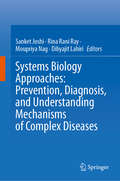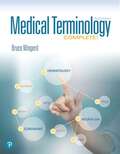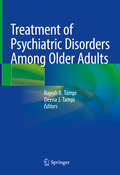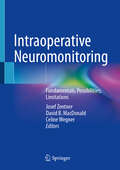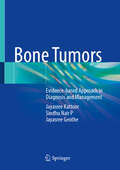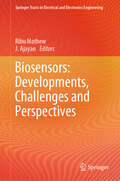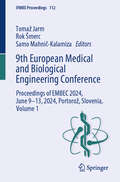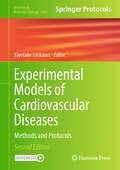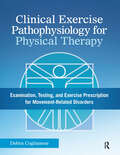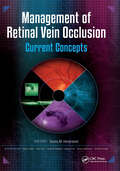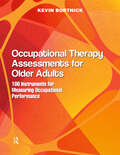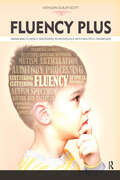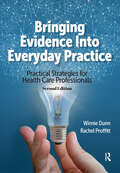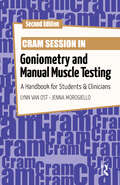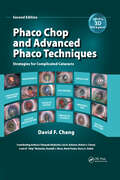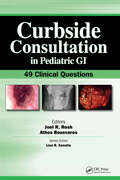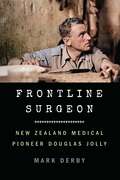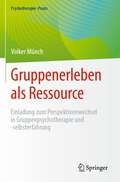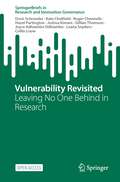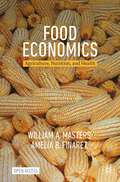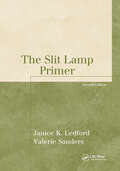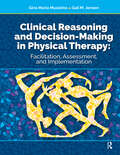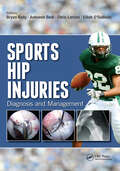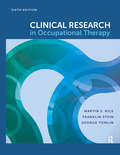- Table View
- List View
Systems Biology Approaches: Prevention, Diagnosis, and Understanding Mechanisms of Complex Diseases
by Sanket Joshi Rina Rani Ray Moupriya Nag Dibyajit LahiriThis book examines the development and applications of system biology approaches for the prevention, diagnosis, and understanding of disease mechanisms. It explores the applications of system biology in infectious diseases, including host-pathogen interaction, and the identification of targets for new therapeutics and intervention strategies. It covers the use of system biology for understanding and treating metabolic disorders towards personalized and precision medicine. The book further discusses the systems biology approaches for understanding the mechanisms of tumor progression and designing more effective cancer therapies. The chapter also reviews the current strategies in autoimmune disease treatment and highlights the opportunity that systems biology represents for the development of better and safer treatments. Importantly, the book discusses the current state of the systems-level understanding of diseases and both the therapeutic and adverse mechanisms of drug actions usingsystem biology approaches. Cutting across the disciplines, this book is a valuable source for researchers in genetics, molecular biology, cell biology, microbiology, and biomedical sciences.
A Guide to Global Language Assessment: A Lifespan Approach
by Mellissa BortzFor decades, the speech-language therapy profession has expressed the need for the development of language assessment materials in languages other than English for children and adults. A Guide to Global Language Assessment: A Lifespan Approach aims to meet this need by providing comprehensive information about how to assess the language of bi- and multilingual and culturally diverse clients across the world.Featuring the viewpoints of contributors from around the world, A Guide to Global Language Assessment also boasts a complete database of available global language assessments.What’s included in A Guide to Global Language Assessment: Case studies, assessment frameworks, and resources for conducting global language assessments for culturally and linguistically diverse populations An array of language assessment methods across a continuum such as ethnographic and dynamic assessments, narratives, and standardized language assessment Methods for developing local norms A Guide to Global Language Assessment: A Lifespan Approach is an essential tool for empowering current and future speech-language therapists, professors, and researchers to address global language assessment across the lifespan.
Medical Terminology Complete!
by Bruce WingerdMedical Terminology Complete! takes a programmed approach to presenting the most current language of healthcare. Organized by body system, the text conveys the medical terms used in medical offices, hospitals and clinics, together with essential A&P information. You'll get step-by-step guidance in building medical terms. Word Part Reminders show you how word parts combine to form a term, while Word Part Breakdowns identify word parts. Some exercises offer word-building practice, while others use medical reports to show how medical terms are used in practice. The 4th Edition improves clinical training for students poised to a launch a healthcare career. New types of chapter-ending exercises, such as Define the Combining Form and Complete the Labels exercises, round out a comprehensive series of practice opportunities.
Treatment of Psychiatric Disorders Among Older Adults
by Rajesh R. Tampi Deena J. TampiThis timely book provides detailed information regarding the latest treatment for psychiatric disorders among the growing population of older adults. The World Health Organization reports that between 2015 and 2050, the proportion of the world's older adults (≥ 60 years) will double from about 12% to almost 22% of the total population, and it is estimated that approximately 20% of older adults have a diagnosable psychiatric disorder. Many of these older adults are prescribed psychotropic medications, but these treatments can result in significant functional decline, cognitive decline, cerebrovascular adverse events, and death. The editors, in collaboration with fellow experts in geriatric psychiatry, provide the scientific background regarding the treatment of a range of psychiatric disorders among older adults. The volume features a comprehensive table of contents covering a range of psychiatry subtopics, such as neurocognitive disorders, depressive disorders, substance use disorders, and anxiety disorders. Each chapter adheres to the same easy-to-follow format, and amongst other information, includes evidence-based assessments, non-pharmacological and pharmacological therapies, potential side-effects and their treatments, and evidence-based treatment algorithms for each disorder. Treatment of Psychiatric Disorders Among Older Adults will be a valuable resource for psychiatrists, geriatricians, students, neurologists, advance practice nurses, psychologists, social workers, occupational therapists, physical therapists, and dieticians who care for older adults with mental health disorders.
Intraoperative Neuromonitoring: Fundamentals, Possibilities, Limitations (Issn Ser.)
by Josef Zentner David B. MacDonald Celine WegnerIntraoperative neurophysiological monitoring (IONM) has gained increasing interest during the past decades and is now an integral part of various surgical disciplines, especially in neurosurgery, but also in otolaryngology, orthopedics, vascular surgery and general surgery. With expanding applications and evolving techniques, the monitoring team is faced with increasingly complex tasks and responsibilities. Despite its importance and significance in modern surgical medicine and the expectations associated with it, IONM is still not a regular part of the training program of medical professionals. Although knowledge on monitoring is imparted in basic courses offered by a few professional societies, systematic training of medical and non-medical staff according to a standardized curriculum is still lacking.This book aims to contribute to closing this gap. It provides a practical guide to help medical, nursing, and technical personnel get familiar with intraoperative neuromonitoring. The basic tenor is to combine theoretical and practical knowledge and thus to systematically convey essential skills about fundamentals, possibilities, but also limitations of IONM to a broad circle of readers. In order to achieve this goal, the text has been reduced to the absolutely necessary length in favor of numerous illustrations and tables.After an introduction to the tasks, the significance, and the historical development of IONM, the anatomical, physiological and physical basics are presented. This is followed by a presentation of various modalities as well as stimulation and recording techniques. The intraoperative part begins with some information on the organizational processes in the operating room, the presentation of safety aspects, and a description of the influences of anesthesia on monitoring, including the special aspects of awake surgery. This is followed by some basic remarks on the interpretation of monitoring results and a rough overview of the application fields of IONM in various disciplines including representative case examples. The manual concludes with an evaluation of the efficiency of monitoring and practical recommendations for the detection and elimination of intraoperative sources of error. Self-tests in individual chapters are intended to give readers the opportunity to determine their level of knowledge.
Bone Tumors: Evidence-based Approach in Diagnosis and Management
by Jayasree Kattoor Jayasree Geothe Sindhu Nair PThe book offers a comprehensive update on bone tumors and tumor like conditions including clinical, pathological and radiological features. It provides a comprehensive coverage of the topic including molecular biology and provides the readers a solid foundation of knowledge for tumor recognition and evaluation. The book includes chapters on synovial and odontogenic tumors as well. Chapters are uniformly designed and provide systematic approach to various tumors and tumor-like lesions of bone. They are divided according to the predominant cell of origin or the predominant matrix produced, such as osteoid producing lesions, chondroid tumors or giant cell rich tumors, thus assisting the reader, as to how to approach such lesions. Chapters include ample radiology and microscopy images and tables for quick reference.The book is an ideal resource and offers assistance to practicing pathologists, radiologists, clinical oncologists, orthopedicians as well as residents and interns in pathology, radiology, oncology and orthopedics in understanding the approach to bone tumors in a systematic way. The book emphasizes on the need for a multidisciplinary approach for the diagnosis of bone tumors.
Biosensors: Developments, Challenges and Perspectives (Springer Tracts in Electrical and Electronics Engineering)
by J. Ajayan Ribu MathewThis book equips its readers with fundamental concepts and a comprehensive understanding of the principle and functionality of biosensors. This book focuses on various biosensor technologies like field effect transistor (FET), plasmonics, bioresorbable biosensors, electro-chemical biosensors, etc., and their applications. The book also covers the reliability aspects and challenges in biosensor development that are a major cause of erroneous calibration and even failure. The book also features the concept of bio receptors, immobilization techniques, target-receptor interactions, surface energy changes, sensitivity, selectivity, etc. This would be an ideal reference for researchers and scholars studying biosensors realized with various material sets and technologies including state-of-the-art modern materials and innovative techniques.
9th European Medical and Biological Engineering Conference: Proceedings of EMBEC 2024, June 9-13, 2024, Portorož, Slovenia, Volume 1 (IFMBE Proceedings #112)
by Samo Mahnič-Kalamiza Tomaž Jarm Rok ŠmercThis book informs on new trends, challenges, and solutions, in the multidisciplinary field of biomedical engineering. It covers traditional topics in biomechanics and biomedical signal processing, as well as recent trends relating to the applications of artificial intelligence and machine learning methods in medicine and biology, and to bioengineering education. Gathering the second volume of the proceedings of the 9th European Medical and Biological Engineering Conference (EMBEC 2024), held on June 9-13, 2024, in Portorož, Slovenia, this book bridges fundamental and clinically-oriented research, emphasizing the role of translational research in biomedical engineering. It aims at inspiring and fostering communication and collaboration between engineers, physicists, biologists, physicians and other professionals dealing with cutting-edge themes in and advanced technologies serving the broad field of biology and healthcare.
Experimental Models of Cardiovascular Diseases: Methods and Protocols (Methods in Molecular Biology #2803)
by Kiyotake IshikawaThis second edition provides new and updated methods for establishing reliable and reproducible experimental models of cardiovascular diseases. Chapters detail practical protocols from expert laboratories focusing on cardiovascular research, that would be critical in exploring novel discoveries in cardiac biology, and the development of effective therapeutic approaches. Written in the highly successful Methods in Molecular Biology series format, chapters include introductions to their respective topics, lists of the necessary materials and reagents, step-by-step, readily reproducible laboratory protocols, and key tips on troubleshooting and avoiding known pitfalls. Authoritative and cutting-edge, Experimental Models of Cardiovascular Diseases: Methods and Protocols, Second Edition aims to provide detailed and practical protocols that will be valuable tools for researchers in cardiology to conduct their research.
Clinical Exercise Pathophysiology for Physical Therapy: Examination, Testing, and Exercise Prescription for Movement-Related Disorders
by Debra CoglianeseIn order to effectively examine, test, and treat patients with exercise, physical therapists need to understand how physiology from the cellular to the systems level provides the basis for normal responses to exercise. But that is not enough. Knowledge about pathophysiology, the changes that lead to abnormal responses to exercise in different patient populations, is also essential. Clinical Exercise Pathophysiology for Physical Therapy: Examination, Testing, and Exercise Prescription for Movement-Related Disorders is a comprehensive reference created to answer the “why” and the “how” to treat patients with exercise by offering both comprehensive information from the research literature, as well as original patient cases.Dr. Debra Coglianese, along with her contributors, have arranged Clinical Exercise Pathophysiology for Physical Therapy into three parts: foundations of physiological responses, pathophysiology of deconditioning and physiology of training, and pathophysiology considerations and clinical practice. The chapters present the physiology and pathophysiology for defined patient populations consistent with the American Physical Therapy Association’s Guide to Physical Therapy Practice.Patient cases also supplement each chapter to illustrate how understanding the content of the chapter informs physical therapy examination, testing, and treatment. The patient/client management model from the Guide to Physical Therapy Practice defines the structure of the patient cases, and the International Classification of Function, Disability, and Health (ICF) model of disablement has been inserted into each patient case. Highlighted “Clinician Comments” appear throughout each patient case to point out the critical thinking considerations.Included with the text are online supplemental materials for faculty use in the classroom.Clinical Exercise Pathophysiology for Physical Therapy: Examination, Testing, and Exercise Prescription for Movement-Related Disorders is a groundbreaking reference for the physical therapy student or clinician looking to understand how physiology and pathophysiology relate to responses to exercise in different patient populations.
Management of Retinal Vein Occlusion: Current Concepts
by Seenu HariprasadManagement of retinal venous occlusions (RVO) has changed dramatically in recent years. With an increase in medical information, technological advances, and clinical trials, ophthalmologists need a concise, updated reference. Management of Retinal Vein Occlusion: Current Concepts fills this current need in the market.In Management of Retinal Vein Occlusion, Dr. Seenu Hariprasad is joined by multiple section editors to provide this easy-to-read and nicely formatted resource, which is divided into organized sections:• Background: The epidemiology, risk factors, and classification of RVO• History: Seven large clinical trials involving RVO and the pros and cons of earlier treatment modalities• Anti-VEGF Therapies: The rationale and outcomes of large clinical trials• Corticosteroid Therapies: The rational and outcomes of various steroid treatment modalities• Imaging: Case presentations and emerging technology that highlights the relationship between peripheral ischemia and macular edema• Difficult cases: Combination therapies, management of recalcitrant cases, and surgical approaches for cases that do not respond to standard management• Future of RVO: A summary overview of the subject and future directionsWith an unparalleled list of contributors that are leaders in the retina field, Management of Retinal Vein Occlusion goes beyond the conclusions of clinical trials and delves deeper into practical recommendations for patient management in daily practice.With abundant illustrations, fundus photographs, concise tables, and summary boxes that enhance the written text, Management of Retinal Vein Occlusion: Current Concepts is a valuable resource.
Occupational Therapy Assessments for Older Adults: 100 Instruments for Measuring Occupational Performance
by Kevin BortnickThe role of measurement and the benefits of outcome measures are defined as important tools used to document change in one or more constructs over time, help to describe a client’s condition, formulate a prognosis, as well as to evaluate the effects of occupational therapy intervention.Occupational Therapy Assessments for Older Adults: 100 Instruments for Measuring Occupational Performance presents over 100 outcome measures in the form of vignettes that encompass a brief description of each instrument, a review of its psychometric properties, its advantages and disadvantages, administration procedures, permissions to use, author contact information, as well as where and how to procure the instrument. Occupational Therapy Assessments for Older Adults by Dr. Kevin Bortnick narrows down the list of possible choices for the occupational therapy student or clinician to only those with an amount of peer review, bibliographic citations, as well as acceptance within the profession. The text also includes research-based information with text citations and has over 100 tables, diagrams, and figures. Included in the review of each outcome measure: Description: A brief record of the measure. Psychometrics: A review of the level of research evidence that either supports or does not support the instrument, including such items as inter-rater, intra-rater, and test-retest reliabilities, as well as internal consistencies and construct validities among others. Advantages: Synopsis of the benefits of using the measure over others including its unique attributes. Disadvantages: A summary of its faults. For example, the amount of research evidence may be limited or the measure may be expensive. Administration: Information regarding how to administer, score, and interpret results. Permissions: How and where to procure the instrument, such as websites where it may be purchased or journal articles or publications that may contain the scale. Summary: A brief summation of important information. Occupational Therapy Assessments for Older Adults: 100 Instruments for Measuring Occupational Performance encourages occupational therapy and occupational therapy assistants to expand their thinking about the use of appropriate outcome measures with older adult populations. Using the appropriate outcome measure based on evidence can aid in the promotion of health, well-being, and participation of clients.
Fluency Plus: Managing Fluency Disorders in Individuals With Multiple Diagnoses
by Kathleen Scaler ScottFluency disorders such as stuttering, cluttering, and atypical disfluency are often accompanied by concomitant speech and language disorders, as well as other disorders impacting and interacting with fluency. Despite this common presentation, there is little training for speech-language pathologists to confidently treat fluency disorders and concomitant disorders together. Fluency Plus: Managing Fluency Disorders in Individuals with Multiple Diagnoses fills this much-needed gap, providing a strong research base along with practical strategies and treatment activities to guide speech-language pathologists in managing clients with fluency and concomitant disorders.Dr. Kathleen Scaler Scott brings her years of clinical experience and her research in the areas of stuttering, cluttering and atypical disfluencies to Fluency Plus, designing it to act as both a textbook for students and a practical guide for the clinician. The comprehensive review of current definitions of fluency disorders and the evidence base for treatments will be of great help to students, while clinicians will appreciate the specific guidelines, strategies, and activities for managing fluency in concomitant disorders.After reviewing general principles and covering how executive functions relate to the management of these multiple concerns, the text addresses seven concomitant disorder areas the speech-language pathologist may encounter in practice. For each disorder category, an overview of potential fluency problems is provided, myths regarding treatment of fluency disorders in each population are debunked, and effective treatment activities are recommended.Some Concomitant Disorders Covered: Intellectual Disability Speech Sound Disorders (apraxia, phonological, articulation disorders) Learning Disabilities, Auditory Processing and Language Disorders Attention Deficit Hyperactivity Disorder Autism Spectrum Disorder Selective Mutism Fluency Plus: Managing Fluency Disorders in Individuals with Multiple Diagnoses helps close an education and training gap for students and clinicians alike by increasing their confidence, knowledge, and skills when dealing with fluency disorders and complex combinations of concomitant disorders.
Bringing Evidence Into Everyday Practice: Practical Strategies for Healthcare Professionals
by Winnie Dunn Rachel ProffittBringing Evidence Into Everyday Practice: Practical Strategies for Health Care Professionals, Second Edition provides a step-by-step process for learning how to use literature to inform quality practices in an accessible workbook format. Bringing Evidence Into Everyday Practice simplifies analyzing research through repetition of core strategies and the systematic introduction of increasingly complex techniques for interpreting literature. Students, early career professionals, and interdisciplinary teams alike can build a common language and structure for selecting and evaluating evidence to incorporate into their practices. What’s included in Bringing Evidence Into Everyday Practice:• Worksheets to guide learning, available in print and as writable PDFs online• Ample opportunities to repeat and practice skills• Summary articles, emerging practices, and data collection• How to search databases, examine quality features, and identify the parts of a research article• A library of articles that learners can access from their libraries or the internetIncluded with the text are online supplemental materials for faculty use in the classroom. Bringing Evidence Into Everyday Practice: Practical Strategies for Health Care Professionals, Second Edition walks readers through each step of reviewing articles in the literature—providing them with a scaffolding of understanding how to evaluate and incorporate evidence into their practice.
Cram Session in Goniometry and Manual Muscle Testing: A Handbook for Students and Clinicians
by Lynn Van Ost Jenna MorogielloNewly updated, Cram Session in Goniometry and Manual Muscle Testing: A Handbook for Students & Clinicians, Second Edition, is a descriptive quick reference guide for rehabilitation professionals organized in a “head-to-toe” format, including more than 400 photographs and supplemented with concise and illustrative examples of various techniques.The new edition of this text maintains the original essence of the first edition while touching upon updated information to speak to new clinicians. Minor revisions, such as adding color to the headers and to the sections, allow the reader easier access to the topics. An expanded appendix and up-to-date content touch on newer technology being used and developed in these areas of clinical evaluation.What is in your Cram Session: In the Goniometry section, subdivisions are broken down into type of joint, capsular pattern, average range of motion for each movement, patient positioning, goniometric alignment, patient substitutions, and alternative methods of measurement. In the Manual Muscle Testing section, subdivisions are broken into the specific movement to be tested, average range of motion, prime movers of the movement, secondary movers of the movement, anti-gravity patient position, gravity minimized patient position, stabilization and grades, substitutions for the movement, and points of interest for that particular muscle group. Cram Session in Goniometry and Manual Muscle Testing: A Handbook for Students & Clinicians, Second Edition, is an informative, well-organized handbook for all students, instructors, and clinicians in physical therapy, occupational therapy, athletic training, orthopedics, or any allied health professional who treats musculoskeletal disorders.
Phaco Chop and Advanced Phaco Techniques: Strategies for Complicated Cataracts
by David F. ChangWhile chopping techniques are particularly advantageous for complicated cataracts, they must be integrated with other devices and strategies. Phaco Chop, the best-selling cataract surgery book, has been revised and updated into a Second Edition to reflect the many advances over the past few years. More than half of the 30 total chapters are new. These detail strategies for complicated cases and introduce femtosecond laser nuclear fragmentation techniques.Dr. David F. Chang is widely acknowledged as one of the best cataract surgical teachers. His video instruction courses for phaco chop and complicated cataracts have consistently ranked among the best attended and top rated at the American Academy of Ophthalmology and American Society of Cataract and Refractive Surgeons meetings for over a decade.The Four Main Sections inside the Second Edition: Phaco Chop Techniques Phacodynamics of Chopping Femtosecond Laser Nuclear Pre-Chopping Complicated Cases and Complications – Strategies and Management Section One is a detailed guide for learning phaco chop. The faculty from Dr. Chang’s popular phaco chop course outlines their pearls based upon extensive experience teaching residents and transitioning surgeons.Section Two provides the general principles of instrumentation and configuring machine parameters. Separate chapters specifically address optimizing the Infiniti, Signature, and Stellaris platforms for chopping. Section Three introduces femtosecond laser nuclear pre chopping with separate chapters on the LenSx, LensAR, and Optimedica platforms. Section Four covers small pupils and IFIS, rock hard and white mature cataracts, weak zonules, and extremely long and short eyes with an emphasis on managing posterior capsule rupture, advanced IOL fixation strategies, and avoiding and managing capsulorrhexis complications. Bonus Video Material!Phaco Chop and Advanced Phaco Techniques, Second Edition includes instructional video that complements and supplements the content of the book. With your book purchase, you will receive a DVD that contains 26 surgical videos in high definition 3D format. With the enclosed 3D glasses—learning intraocular surgical techniques is taken to a new level.Additionally, you will receive access to a website that includes additional companion surgical videos narrated by Dr. Chang in 2D format—watch, listen, view repeatedly, and learn the techniques!The narrated videos produced by Dr. Chang illustrate advanced surgical techniques and technologies. Together with over 400 high-resolution operative photographs, this paired format overcomes the limitations of learning new and advanced surgical techniques from written text alone.With its comprehensive and integrated emphasis on advanced surgical techniques, optimizing phaco technology, and complication management, Phaco Chop and Advanced Phaco Techniques: Strategies for Complicated Cataracts, Second Edition will appeal to residents and transitioning surgeons as well as high volume surgeons interested in honing their most advanced phaco skills.
Curbside Consultation in Pediatric GI: 49 Clinical Questions (Curbside Consultation in Pediatrics)
by Athos Bousvaros Joel RoshAre you looking for concise, practical answers to those questions that are often left unanswered by traditional pediatric GI references? Are you seeking brief, evidence-based advice for complicated cases or controversial decisions? Curbside Consultation in Pediatric GI: 49 Clinical Questions provides quick answers to the tricky questions most commonly posed during a “curbside consultation” between pediatricians. Drs. Joel R. Rosh and Athos Bousvaros have designed this unique reference which offers expert advice, preferences, and opinions on tough clinical questions commonly associated with pediatric GI. The unique Q&A format provides quick access to current information related to pediatric GI with the simplicity of a conversation between two colleagues. Numerous images, diagrams, and references allow readers to browse large amounts of information in an expedited fashion. Some of the questions that are answered: • How is infantile colic diagnosed and treated?• How is GERD diagnosed in infants and what are the best treatments?• How can I optimize my treatment of childhood constipation and does this vary by age?• How can I effectively intervene in a child that is overweight or obese?• Celiac disease seems so much more common—is this an epidemic?• Why have food allergies become so common and what are the most accurate means of diagnosis? Curbside Consultation in Pediatric GI: 49 Clinical Questions provides information basic enough for residents while also incorporating expert advice that even high-volume pediatricians will appreciate. Pediatricians, nurse practitioners, physician assistants, family practitioners and pediatric residents will benefit from the user-friendly, casual format and the expert advice contained within.
Frontline Surgeon: New Zealand Medical Pioneer Douglas Jolly
by Mark DerbyAlthough a young doctor when he volunteered for the Spanish Civil War in late 1936, New Zealander Douglas Jolly swiftly acquired a reputation as one of the most gifted and energetic surgeons of the Republican Army&’s medical services. Over the next two years he performed countless life-saving operations on wounded combatants from both sides of the conflict, as well as on civilians. Tireless, dedicated, and courageous, he developed significant and innovative treatment systems based on the principle of working as near as possible to the front line. Jolly used this unprecedented battlefield experience to write a manual that was widely used in World War II and the Korean and Vietnam Wars.Frontline Surgeon traces Jolly&’s remarkable career from medical training in 1920s New Zealand, postgraduate study during the rise of fascism in Europe, almost a decade of frontline surgery, and into civilian life as medical director of Britain&’s largest hospital for amputees. One of the greatest war surgeons of the twentieth century, Jolly has been mysteriously omitted from the ranks of pioneers of modern medicine. This engaging biography, intensively researched in many countries, both explains and redresses that omission.
Gruppenerleben als Ressource: Einladung zum Perspektivenwechsel in Gruppenpsychotherapie und -selbsterfahrung (Psychotherapie: Praxis)
by Volker MünchDieses Fachbuch für Psychotherapeuten und Gruppentherapeuten regt den Leser, die Leserin entlang des eigenen Lebenslaufs an, eigene Gruppenerfahrungen neu zu reflektieren – und diese Einsichten in Beziehung zu Therapieprozessen zu setzen. Psychisches Leben und persönliche Entwicklung entsteht immer in Netzwerken. Analytische Gruppentherapie nutzt dies und macht psychische Vorgänge sichtbar, die in Einzelbehandlungen zu oft unklar bleiben. Unser Bild der psychischen Entwicklung des Menschen wandelt sich angesichts neurowissenschaftlicher Erkenntnisse und vor dem Hintergrund komplexer gesellschaftlicher Herausforderungen unserer Zeit in ein Bild des Menschen als Social Animal. Wir sehen einen Aufschwung für die Gruppentherapie und eine Öffnung gegenüber Theorien, die unsere gegenseitige Abhängigkeit in einem positiven Sinn betonen. Zusammengehörigkeit und Solidarität können so gemeinschaftlich eingeübt werden und transformatorische Kraft für Veränderung beim Einzelnen, aber auch für dieGesellschaft entfalten. Viele lebensnahe Beispiele vor allem aus therapeutischen Gruppen illustrieren dies. Geschrieben für:Psychotherapeut*innen, Gruppenpsychotherapeut*innen, Gruppenleiter*innen im medizinischen und sozialen Bereich.Über den Autor: Dipl. Psych. Volker Münch, Psychologischer Psychotherapeut in eigener Praxis in München. Lehranalytiker, Supervisor und Dozent an der MAP, München. Veröffentlichungen zu den Themen Therapeutische Haltung, Digitalisierung, Krise in der Lebensmitte.
Vulnerability Revisited: Leaving No One Behind in Research (SpringerBriefs in Research and Innovation Governance)
by Doris Schroeder Roger Chennells Kate Chatfield Hazel Partington Joshua Kimani Gillian Thomson Joyce Adhiambo Odhiambo Leana Snyders Collin LouwOpen access. This open-access book discusses vulnerability and the protection-inclusion dilemma of including those who suffer from serious poverty, severe stigma, and structural violence in research. Co-written with representatives from indigenous peoples in South Africa and sex workers in Nairobi, the authors come down firmly on the side of inclusion. In the spirit of leaving no one behind in research, the team experimented with data collection methods that prioritize research participant needs over researcher needs. This involved foregoing the collection of personal data and community researchers being involved in all stages of the research. In the process, the term ‘vulnerability’ was illuminated across significant language barriers as it was defined by indigenous peoples and sex workers themselves. The book describes a potential alternative to exclusion from research that moves away from traditional research methods. By ensuring that the research is led by vulnerable groups for vulnerable groups, it offers an approach that fosters trust and collaboration with benefits for the community researchers, the wider community as well as research academics. Those living in low-income settings, in dire situations that are summarized with the term ‘vulnerability’ know best what their problems are and which priorities they have. To exclude them from research for their own protection is a patronizing approach which insinuates that researchers and research ethics committees know best. The team from this book have shown that minimally risky and minimally burdensome research tailored towards the needs of highly marginalized and stigmatized communities can be scientifically valuable as well as inclusive and equitable. I congratulate them. Prof. Klaus Leisinger, President Global Values Alliance, Former personal advisor to Kofi Annan on corporate responsibility
Food Economics: Agriculture, Nutrition, and Health (Palgrave Studies in Agricultural Economics and Food Policy)
by William A. Masters Amelia B. FinaretFood Economics provides a unified introduction to the economics of agricultural production, business decisions, consumer behavior, and the government policies that shape our food system. This open access textbook begins with economic principles derived using graphical techniques to explain and predict observed prices, quantities, and other outcomes as a result of individual choices influenced by market structure and public policies. The second half of the book explores available data globally and for the US, covering a wide range of questions in agriculture and economic development, food marketing, and consumption. Food Economics and its accompanying online resources are designed for advanced undergraduate or introductory graduate courses in agriculture, food, and nutrition policy. The book covers the standard diagrams taught in principles-level courses, with concrete examples and practical insights regarding food production, consumption, and trade. Online resources include data sources, and course materials, including slides, exercises, exams, and answer keys.
The Slit Lamp Primer (The Basic Bookshelf for Eyecare Professionals)
by Janice K. LedfordThe Slit Lamp Primer is the complete book on the slit lamp for the ophthalmic and optometric office. Now updated into a second edition, this user-friendly introduction to the slit lamp microscope highlights the instrument's basic parts as well as examination and illumination techniques. Janice Ledford and Valerie Sanders explain more than just the fundamentals of the slit lamp. Written in a conversational style with supplemental photographs and diagrams, The Slit Lamp Primer delves into issues concerning the normal, postoperative, and problematic eye. Features of the patient history, including medications, are examined in light of the possible slit lamp findings. Detailed notes for proper documentation are included, along with tables to give guidelines for subjective grading of the findings. Updated and key features: The examination of patients on various systemic medications with a list of drugs that may have side effects visible with the slit lamp The examination of post-operative patients, with a new section that focuses on patients who have undergone refractive surgery Up-to-date study icons, key points listed at the beginning of each chapter, and "What the Patient Needs to Know" sidebars Photographs and descriptions of parts and care of the slit lamp Atlas of photographs of the normal eye Photographs of pathology Tables to assist in contact lens evaluation The Slit Lamp Primer, Second Edition is a valuable addition to the reference library of any ophthalmic and optometric paraprofessional or student. Explore the workings of a useful and effective instrument with the most practical and user-friendly book on the subject available today.
Clinical Reasoning and Decision Making in Physical Therapy: Facilitation, Assessment, and Implementation
by Gail Jensen Gina MusolinoClinical reasoning is an essential non-negotiable element for all health professionals. The ability of the health professional to demonstrate professional competence, compassion, and accountability depend on a foundation of sound clinical reasoning. The clinical reasoning process needs to bring together knowledge, experience, and understanding of people, the environment, and organizations along with a strong moral compass in making sound decisions and taking necessary actions. While clinical reasoning and the role of mentors has been a focus of the continued growth and development of residency programs in physical therapy, there is a critical need to have a broader, in-depth look at how educators across academic and clinical settings intentionally facilitate the development of clinical reasoning skills across one’s career. Clinical Reasoning and Decision Making in Physical Therapy: Facilitation, Assessment, and Implementation fills this need by providing a comprehensive and in-depth focus on development of the patient-client management skills of clinical reasoning and clinical decision-making. It takes into account teaching and learning strategies, assessment, and technological applications across the continuum from novice to residents/fellows-in-training, along with academic and clinical faculty for both entry-level and specialist practice. Drs. Gina Maria Musolino and Gail Jensen have designed this comprehensive resource with contributions from professional colleagues. The text centers on life-long learning by encouraging the development of clinical reasoning abilities from professional education through residency education. The aim and scope of the text is directed for physical therapy education, to enhance clinical reasoning and clinical decision-making for developing professionals and post-professionals in both clinical and academic realms, and for the development of clinical and academic faculty.Clinical Reasoning and Decision Making in Physical Therapy uniquely offers both evidence-based approaches and pragmatic consultation from award-winning authors with direct practice experiences developing and implementing clinical reasoning/clinical decision-making in practice applications for teaching students, residents, patients, and clinical/academic faculty in classrooms, clinics, and through simulation and telehealth.Clinical Reasoning and Decision Making in Physical Therapy is the first of its kind to address this foundational element for practice that is key for real-world practice and continuing competence as a health care professional. Physical therapy and physical therapist assistant students, faculty, and clinicians will find this to be an invaluable resource to enhance their clinical reasoning and decision making abilities.
Sports Hip Injuries: Diagnosis and Management
by Bryan Kelly Asheesh Bedi Chris Larson Eilish O'SullivanIn the world of sports, hip injuries among an athletic population can be very difficult to diagnose and manage. That’s why Sports Hip Injuries: Diagnosis and Management is a comprehensive guide to diagnosing and managing sports hip injuries and hip preservation. Drs. Bryan Kelly, Asheesh Bedi, Chris Larson, and Eilish O’Sullivan are leaders in the field of hip preservation. They present Sports Hip Injuries: Diagnosis and Management in a concise manner by focusing on hip and pelvis disorders and cover all of the typical disorders seen in athletes presenting with hip and pelvic pain. The anatomy, presentation, clinical evaluation, imaging, nonsurgical and surgical treatment, and post-surgical rehabilitation of hip joint disorders are presented clearly throughout.Some of the topics Include: Femoroacetabular impingement Hip instability/dysplasia Athletic pubalgia/core muscle injury Stress fractures and traumatic sports injuries of the hip and pelvis Myotendinous injuries and nerve entrapment disorders of the hip and pelvis Rehabilitation guidelines and return to sport outcomes Sports Hip Injuries: Diagnosis and Management is an invaluable resource for sports medicine providers including orthopedic surgeons and fellows that care for patients presenting with hip pain for athletes at all levels, as well as physical therapists and athletic trainers.
Clinical Research in Occupational Therapy, Sixth Edition
by Franklin Stein Martin Rice George TomlinIn this new edition, Dr. George Tomlin joins Dr. Martin S. Rice and Dr. Franklin Stein to add expertise and knowledge of the occupational therapy field. With the combined knowledge and skills of the authors Clinical Research in Occupational Therapy, Sixth Edition includes many valuable updates and enables the graduate student and clinical researcher to carry out a research study from the formulation of a research hypothesis to collecting, analyzing, and interpreting data in user-friendly, step-by-step procedures. This Sixth Edition brings noteworthy changes, improvements, and enhancements, including the following: A thorough update of the published research in occupational therapy and health care Major revisions in all the chapters The addition of a new chapter on single-case experimental research Updated research boxes and contemporary examples of both quantitative and qualitative research Updated compilation of tests and evaluations used by occupation therapists in research studies as outcome instruments and for clinical assessments Revision and additions to the glossary of terms and statistics Updated examples of the institutional review board application forms Updated landmarks in the history of occupational therapy Updated interfacing example with a popular statistical software, including data organization analysis and interpretation Updated statistical tables Clinical Research in Occupational Therapy, Sixth Edition is a valuable resource for students, clinicians and researchers. The text can be used as a complete self-tutorial that provides the reader with the knowledge and skills to design and carry out a research project, from hypothesis through data collection and analysis. The text is written to help the reader evaluate the quality and rigor of research studies. The Sixth Edition incorporates recent research in occupational therapy to help the reader design a feasible research project and understand and appreciate the literature of the field.
